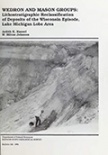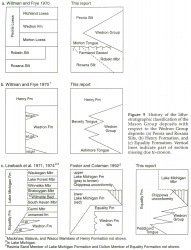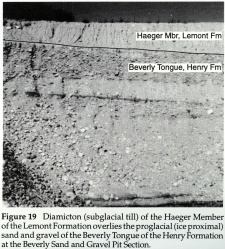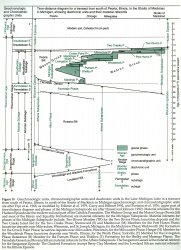Historical:Beverly Tongue
Lithostratigraphy: Mason Group >>Henry Formation >>Beverly Tongue
Chronostratigraphy: Cenozoic Erathem >>Quaternary System >>Pleistocene Series
Authors
Ardith K. Hansel and W. Hilton Johnson
Name
Original description
This report.
Derivation
Beverly Sand and Gravel Pit, northeastern Illinois.
History/background
Proglacial sand and gravel below Haeger Member diamicton is classified in this report as a formal unit of the Henry Formation (fig. 9b). It is a thick (up to 30 m [98 ft]), laterally extensive sand and gravel deposit that is an important aggregate resource and aquifer in parts of McHenry, Lake, Kane, and Cook Counties in northeastern Illinois. Beyond the boundary of the Haeger Member, this sand and gravel is continuous at the surface with the Henry Formation deposited in a bouldery and cobbly outwash plain along the front of the Woodstock and West Chicago Moraines in McHenry, Kane, and Du Page Counties (Masters 1978). In places along the front of the West Chicago Moraine in Du Page County, the Beverly Tongue underlies clayey diamicton of the Wadsworth Formation (Hansel and Johnson 1987).
Type section
Beverly Sand and Gravel Pit, a large pit in Kane and Cook Counties about 3.3 kilometers (2 mi) east of state highway 25 and Interstate 90 intersection northeast of Elgin; good for lithology and upper boundary (fig. 19).
Stratigraphic relationships
The Beverly Tongue is the stratified sand and gravel of the Henry Formation that extends beneath the Haeger Member diamicton of the Lemont Formation. In places it is interfingered with fine grained sediment of the Equality Formation and/or diamicton of the Haeger Member.
The stratified sequence of the Beverly Tongue is often gradational and/or interfingered with a finer grained tongue of the Equality Formation. Where underlain by older diamicton units, the lower contact of the Beverly Tongue is readily distinguishable. Although the stratified sediment of the Beverly Tongue may contain diamicton beds in its upper part, an erosional contact is generally present at the base of the more massive Haeger diamicton, and it can be used to separate the two units.
Extent and thickness
The Beverly Tongue of the Henry Formation is a fairly continuous subsurface unit at the base of the Haeger Member in the Harvard Sublobe area in northeastern Illinois. It is up to about 30 meters (98 ft) thick.
Lithology
The Beverly Tongue consists of fingers and lentils of medium to coarse grained, stratified sediment that underlies the Haeger Member diamicton of the Lemont Formation, or less commonly diamicton of the Wadsworth Formation. Regionally, the succession of deposits in the Beverly Tongue is a coarsening-upward sequence of sand and gravel, which may contain intercalated diamicton lenses and tongues. Cobble to boulder gravel is common in the upper part of the sequence and is similar lithologically to the Haeger Member. The gravel contains about 90% sedimentary rocks, about 75% of which is dolomite, and about 10% igneous and metamorphic rocks (Hansel et al. 1985a).
Contacts
Lower boundary: the contact with a tongue of the Equality Formation, the Yorkville Member (Lemont Formation), the Tiskilwa Formation, or older units. Upper boundary: the Haeger Member of the Lemont Formation or the Wadsworth Formation.
Age and correlation
The Beverly Tongue was deposited as the Haeger ice margin advanced to the Woodstock Moraine in the Harvard Sublobe area during the early part of the Woodstock Phase of the Michigan Subepisode, probably between about 16,500 and 16,000 radiocarbon years ago (Hansel and Johnson 1992; fig. 10). It correlates with an unnamed tongue of the Henry Formation in the Joliet Sublobe area and the basal sand and gravel unit of the New Berlin Member of the Holy Hill Formation in Wisconsin (Mickelson et al. 1984, Mickelson and Syverson, in press).
|
Environments of deposition
The Beverly Tongue is the proglacial fluvial facies of a glacigenic sequence that includes subglacial till of the Haeger Member. Regionally, the proglacial sequence includes distal fine grained lacustrine and fluvial sediment (Equality Formation tongue) and medial and proximal sand and gravel (Beverly Tongue), which is overlain by diamicton of sediment flow and subglacial origin of the Haeger Member (Cobb and Fraser 1981, Fraser and Cobb 1982, Hansel and Johnson 1987).
Remarks
New unit. Includes sand and gravel formally classified as part of the Haeger Till Member.
References
COBB, J. C., and G. S. FRASER, 1981, Application of Sedimentology to Development of Sand and Gravel Resources in McHenry and Kane Counties, Northeastern Illinois: Illinois State Geological Survey Illinois Mineral Notes 82, 17 p.
FRASER, G. S., and J. C. COBB, 1982, Late Wisconsinan proglacial sedimentation along the West Chicago Moraine in northeastern Illinois: Journal of Sedimentary Petrology, v. 52, no. 2, p. 473-491.
HANSEL, A. K., and W. H. JOHNSON, 1987, Ice marginal sedimentation in a late Wisconsinan end moraine complex, northeastern Illinois, USA, in J. J. M. van der Meer, editor, Tills and Glaciotectonics: A. A. Balkema, Rotterdam, p. 97-104.
HANSEL, A. K., and W. H. JOHNSON, 1992, Fluctuations of the Lake Michigan Lobe during the late Wisconsin Subepisode: Sveriges Geologiska Undersoekning, Series Ca 81, p. 133-144.
HANSEL, A .K., J. M. MASTERS, and B. J. SOCHA, 1985a, The Beverly Section, Stop 3, in W. H. Johnson, A. K. Hansel, B. J. Socha, L. R. Follmer, and J. M. Masters, Depositional Environments and Correlation Problems of the Wedron Formation (Wisconsinan) in Northeastern Illinois: Illinois State Geological Survey Guidebook 16, p. 53-70.
MASTERS, J. M., 1978, Sand and Gravel and Peat Resources in Northeastern Illinois: Illinois State Geological Survey Circular 503, 11 p.
MICKELSON, D. M., L. CLAYTON, R. W. BAKER, W. H. MODE, and A. F. SCHNEIDER, 1984, Pleistocene Stratigraphic Units of Wisconsin: Wisconsin Geological and Natural History Survey Miscellaneous Paper 84-1, 107 p.
MICKELSON, D. M., and K. M. SYVERSON, in press, Pleistocene Geology of Ozaukee and Washington Counties, Wisconsin: Wisconsin Geological and Natural History Survey Bulletin 91.
ISGS Codes
| Stratigraphic Code | Geo Unit Designation |
|---|---|



